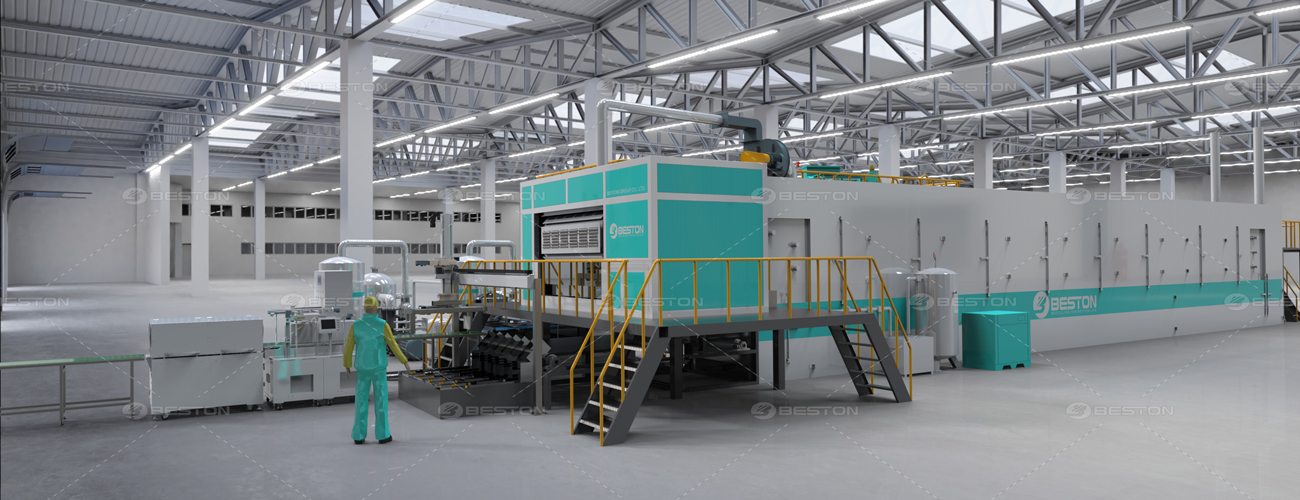An egg tray machine is a piece of essential machinery used in the manufacturing process of egg trays, which are commonly used in the packaging and transportation of eggs. The working principle of an egg tray machine is a combination of mechanical, hydraulic, and thermal processes that transform raw paper pulp into a fully formed and functional product. These machines are widely used in egg tray manufacturing units to produce environmentally friendly, cost-effective solutions for egg packaging.
Process Overview
The process begins with the preparation of pulp. Raw materials, primarily consisting of recycled paper, are mixed with water to form a slurry. This slurry is then fed into the pulp molding machine, which is responsible for shaping the mixture into the desired form. The pulp is evenly distributed onto a mold and pressed to remove excess water, forming a preliminary egg tray shape.
Once the tray is molded, it goes through a drying process. In the case of an egg tray making machine fully automatic, the drying process is typically carried out using either natural or mechanical means, depending on the machine’s design and the production capacity of the unit. The drying stage is critical to ensuring that the trays maintain their shape and strength. High-quality drying systems are integrated into the machine, reducing the overall energy consumption and increasing efficiency.
Key Components of the Machine
The pulp molding machine, an integral part of the system, plays a pivotal role in shaping the slurry into egg trays. It uses molds with cavities designed specifically for egg packaging. The process is automated in many modern egg tray machines, where the pulp is automatically fed, and the trays are molded and transferred to the drying area with minimal human intervention.
A fully automatic machine provides seamless production. Such machines incorporate sensors and control systems to monitor and regulate various stages, from pulp preparation to drying, ensuring optimal output and uniformity. Automation is beneficial in increasing productivity, reducing labor costs, and improving consistency in the final product.
Drying and Forming
After the egg tray has been molded, it is essential to dry the product to ensure that it is durable and rigid enough to support eggs during transportation. Depending on the machine’s capacity, this can be achieved through either a conveyor belt system, where the trays move through a series of drying chambers, or through natural drying methods, where trays are air-dried.
The drying system used in an egg tray manufacturing unit is vital for optimizing production efficiency. Advanced drying systems employ heat exchangers or use infrared radiation to speed up the drying process while consuming minimal energy. For larger-scale operations, drying chambers equipped with multiple levels can handle a higher throughput, thus improving productivity.
Cost Considerations
When considering the beston egg tray machine price, it is important to evaluate both the initial investment and the long-term operational costs. While the cost of a fully automatic egg tray making machine may be higher compared to manual alternatives, the enhanced productivity and reduced labor requirements typically result in cost savings over time. Additionally, automation offers the advantage of consistent quality, making it a desirable option for businesses aiming for large-scale production.
Conclusion
In conclusion, an egg tray machine operates through a series of well-coordinated steps that include pulp molding, drying, and forming, all of which are critical to producing high-quality egg trays. A fully automatic egg tray making machine offers significant advantages in terms of efficiency, cost-effectiveness, and consistent production. As the demand for environmentally friendly packaging solutions continues to rise, the role of these machines in the egg packaging industry will only become more prominent. The proper selection of a pulp molding machine and drying system is essential for ensuring optimal production capacity and product quality in an egg tray manufacturing unit.


